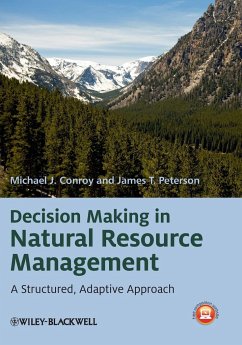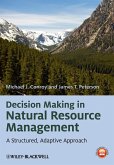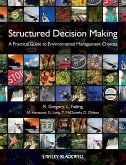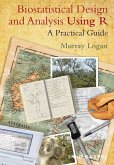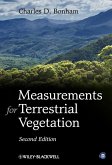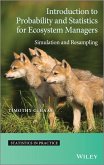- Broschiertes Buch
- Merkliste
- Auf die Merkliste
- Bewerten Bewerten
- Teilen
- Produkt teilen
- Produkterinnerung
- Produkterinnerung
This book is intended for use by natural resource managers and scientists, and students in the fields of natural resource management, ecology, and conservation biology, who are confronted with complex and difficult decision making problems. The book takes readers through the process of developing a structured approach to decision making, by firstly deconstructing decisions into component parts, which are each fully analyzed and then reassembled to form a working decision model. The book integrates common-sense ideas about problem definitions, such as the need for decisions to be driven by…mehr
Andere Kunden interessierten sich auch für
![Decision Making in Natural Resource Management Decision Making in Natural Resource Management]() Michael J. ConroyDecision Making in Natural Resource Management160,99 €
Michael J. ConroyDecision Making in Natural Resource Management160,99 €![Structured Decision Making Structured Decision Making]() Robin GregoryStructured Decision Making201,99 €
Robin GregoryStructured Decision Making201,99 €![Structured Decision Making Structured Decision Making]() Robin GregoryStructured Decision Making89,99 €
Robin GregoryStructured Decision Making89,99 €![Choosing and Using Statistics Choosing and Using Statistics]() Calvin DythamChoosing and Using Statistics42,99 €
Calvin DythamChoosing and Using Statistics42,99 €![Biostatistical Design and Anal Biostatistical Design and Anal]() Murray LoganBiostatistical Design and Anal123,99 €
Murray LoganBiostatistical Design and Anal123,99 €![Measurements for Terrestrial Vegetation Measurements for Terrestrial Vegetation]() Charles D. BonhamMeasurements for Terrestrial Vegetation112,99 €
Charles D. BonhamMeasurements for Terrestrial Vegetation112,99 €![Introduction to Probability and Statistics for Ecosystem Managers Introduction to Probability and Statistics for Ecosystem Managers]() Timothy C. HaasIntroduction to Probability and Statistics for Ecosystem Managers105,99 €
Timothy C. HaasIntroduction to Probability and Statistics for Ecosystem Managers105,99 €-
-
-
This book is intended for use by natural resource managers and scientists, and students in the fields of natural resource management, ecology, and conservation biology, who are confronted with complex and difficult decision making problems. The book takes readers through the process of developing a structured approach to decision making, by firstly deconstructing decisions into component parts, which are each fully analyzed and then reassembled to form a working decision model. The book integrates common-sense ideas about problem definitions, such as the need for decisions to be driven by explicit objectives, with sophisticated approaches for modeling decision influence and incorporating feedback from monitoring programs into decision making via adaptive management. Numerous worked examples are provided for illustration, along with detailed case studies illustrating the authors' experience in applying structured approaches. There is also a series of detailed technical appendices. An accompanying website provides computer code and data used in the worked examples.
Additional resources for this book can be found at: www.wiley.com/go/conroy/naturalresourcemanagement.
Hinweis: Dieser Artikel kann nur an eine deutsche Lieferadresse ausgeliefert werden.
Additional resources for this book can be found at: www.wiley.com/go/conroy/naturalresourcemanagement.
Hinweis: Dieser Artikel kann nur an eine deutsche Lieferadresse ausgeliefert werden.
Produktdetails
- Produktdetails
- Verlag: Wiley & Sons
- 1. Auflage
- Seitenzahl: 480
- Erscheinungstermin: 18. März 2013
- Englisch
- Abmessung: 254mm x 178mm x 25mm
- Gewicht: 887g
- ISBN-13: 9780470671740
- ISBN-10: 0470671742
- Artikelnr.: 36842190
- Herstellerkennzeichnung
- Libri GmbH
- Europaallee 1
- 36244 Bad Hersfeld
- gpsr@libri.de
- Verlag: Wiley & Sons
- 1. Auflage
- Seitenzahl: 480
- Erscheinungstermin: 18. März 2013
- Englisch
- Abmessung: 254mm x 178mm x 25mm
- Gewicht: 887g
- ISBN-13: 9780470671740
- ISBN-10: 0470671742
- Artikelnr.: 36842190
- Herstellerkennzeichnung
- Libri GmbH
- Europaallee 1
- 36244 Bad Hersfeld
- gpsr@libri.de
MICHAEL J. CONROY is a Senior Research Scientist for the Warnell School of Forestry and Natural Resources at the University of Georgia. He is the author of three previous books and has over thirty years' experience in the application of quantitative solutions to problems in natural resource management. He teaches workshops in modeling, statistical estimation, and structured decision making for students and professionals both in the US and internationally. JAMES T. PETERSON is the Assistant Unit Leader and Associate Professor for the USGS Oregon Cooperative Fish and Wildlife Research Unit at Oregon State University. He has been developing and teaching courses in applied quantitative decision making to students and professionals working in natural resources and related disciplines for more than a decade.
List of boxes xi
Preface xiii
Acknowledgements xiv
Guide to using this book xv
Companion website xvii
PART I. INTRODUCTION TO DECISION MAKING 1
1 Introduction: Why a Structured Approach in Natural Resources? 3
The role of decision making in natural resource management 4
Common mistakes in framing decisions 5
What is structured decision making (SDM)? 6
Why should we use a structured approach to decision making? 7
Limitations of the structured approach to decision making 8
Adaptive resource management 9
Summary 10
References 10
2 Elements of Structured Decision Making 13
First steps: defining the decision problem 13
General procedures for structured decision making 15
Predictive modeling: linking decisions to objectives prospectively 17
Uncertainty and how it affects decision making 18
Dealing with uncertainty in decision making 21
Summary 23
References 23
3 Identifying and Quantifying Objectives in Natural Resource Management 24
Identifying objectives 24
Identifying fundamental and means objectives 25
Clarifying objectives 28
Separating objectives from science 29
Barriers to creative decision making 30
Types of fundamental objectives 32
Identifying decision alternatives 34
Quantifying objectives 38
Dealing with multiple objectives 38
Multi-attribute valuation 41
Utility functions 43
Other approaches 50
Additional considerations 52
Decision, objectives, and predictive modeling 55
References 55
4 Working with Stakeholders in Natural Resource Management 57
Stakeholders and natural resource decision making 57
Stakeholder analysis 59
Stakeholder governance 62
Working with stakeholders 68
Characteristics of good facilitators 68
Getting at stakeholder values 71
Stakeholder meetings 72
The first workshop 74
References 76
Additional reading 76
PART II. TOOLS FOR DECISION MAKING AND ANALYSIS 77
5 Statistics and Decision Making 79
Basic statistical ideas and terminology 80
Using data in statistical models for description and prediction 100
Linear models 104
Hierarchical models 116
Bayesian inference 129
Resampling and simulation methods 140
Statistical significance 145
References 146
Additional reading 146
6 Modeling the Influence of Decisions 147
Structuring decisions 147
Influence diagrams 148
Frequent mistakes when structuring decisions 153
Defining node states 157
Decision trees 159
Solving a decision model 160
Conditional independence and modularity 164
Parameterizing decision models 165
Elicitation of expert judgment 179
Quantifying uncertainty in expert judgment 188
Group elicitation 189
The care and handling of experts 190
References 191
Additional reading 191
7 Identifying and Reducing Uncertainty in
Decision Making 192
Types of uncertainty 192
Irreducible uncertainty 193
Reducible uncertainty 194
Effects of uncertainty on decision making 197
Sensitivity analysis 203
Value of information 217
Reducing uncertainty 220
References 230
Additional reading 231
8 Methods for Obtaining Optimal Decisions 232
Overview of optimization 233
Factors affecting optimization 234
Multiple attribute objectives and constrained optimization 239
Dynamic decisions 246
Optimization under uncertainty 249
Analysis of the decision problem 253
Suboptimal decisions and "satisficing" 256
Other problems 257
Summary 258
References 258
PART III. APPLICATIONS 261
9 Case Studies 263
Case study 1 Adaptive Harvest Management of American Black Ducks 263
Case study 2 Management of Water Resources in the Southeastern US 276
Case study 3 Regulation of Largemouth Bass Sport Fishery in Georgia 284
Summary 291
References 291
10 Summary, Lessons Learned, and Recommendations 294
Summary 294
Lessons learned 294
Structured decision making for Hector's Dolphin conservation 295
Landowner incentives for conservation of early successional habitats in
Georgia 298
Cahaba shiner 299
Other lessons 303
References 304
PART IV. APPENDICES 307
Appendix A Probability and Distributional Relationships 309
Probability axioms 309
Conditional probability 309
Conditional independence 310
Expected value of random variables 311
Law of total probability 311
Bayes' theorem 312
Distribution moments 313
Sample moments 316
Additional reading 316
Appendix B Common Statistical Distributions 317
General distribution characteristics 317
Continuous distributions 320
Discrete distributions 329
Reference 338
Additional Reading 338
Appendix C Methods for Statistical Estimation 339
General principles of estimation 339
Method of moments 342
Least squares 343
Maximum likelihood 346
Bayesian approaches 353
References 372
Appendix D Parsimony, Prediction, and Multi-Model Inference 373
General approaches to multi-model inference 373
Multi-model inference and model averaging 376
Multi-model Bayesian inference 380
References 383
Appendix E Mathematical Approaches to Optimization 384
Review of general optimization principles 385
Classical programming 392
Nonlinear programming 397
Linear programming 399
Dynamic decision problems 402
Decision making under structural uncertainty 419
Generalizations of Markov decision processes 427
Heuristic methods 427
References 429
Appendix F Guide to Software 430
Appendix G Electronic Companion to Book 432
Glossary 433
Index 449
Preface xiii
Acknowledgements xiv
Guide to using this book xv
Companion website xvii
PART I. INTRODUCTION TO DECISION MAKING 1
1 Introduction: Why a Structured Approach in Natural Resources? 3
The role of decision making in natural resource management 4
Common mistakes in framing decisions 5
What is structured decision making (SDM)? 6
Why should we use a structured approach to decision making? 7
Limitations of the structured approach to decision making 8
Adaptive resource management 9
Summary 10
References 10
2 Elements of Structured Decision Making 13
First steps: defining the decision problem 13
General procedures for structured decision making 15
Predictive modeling: linking decisions to objectives prospectively 17
Uncertainty and how it affects decision making 18
Dealing with uncertainty in decision making 21
Summary 23
References 23
3 Identifying and Quantifying Objectives in Natural Resource Management 24
Identifying objectives 24
Identifying fundamental and means objectives 25
Clarifying objectives 28
Separating objectives from science 29
Barriers to creative decision making 30
Types of fundamental objectives 32
Identifying decision alternatives 34
Quantifying objectives 38
Dealing with multiple objectives 38
Multi-attribute valuation 41
Utility functions 43
Other approaches 50
Additional considerations 52
Decision, objectives, and predictive modeling 55
References 55
4 Working with Stakeholders in Natural Resource Management 57
Stakeholders and natural resource decision making 57
Stakeholder analysis 59
Stakeholder governance 62
Working with stakeholders 68
Characteristics of good facilitators 68
Getting at stakeholder values 71
Stakeholder meetings 72
The first workshop 74
References 76
Additional reading 76
PART II. TOOLS FOR DECISION MAKING AND ANALYSIS 77
5 Statistics and Decision Making 79
Basic statistical ideas and terminology 80
Using data in statistical models for description and prediction 100
Linear models 104
Hierarchical models 116
Bayesian inference 129
Resampling and simulation methods 140
Statistical significance 145
References 146
Additional reading 146
6 Modeling the Influence of Decisions 147
Structuring decisions 147
Influence diagrams 148
Frequent mistakes when structuring decisions 153
Defining node states 157
Decision trees 159
Solving a decision model 160
Conditional independence and modularity 164
Parameterizing decision models 165
Elicitation of expert judgment 179
Quantifying uncertainty in expert judgment 188
Group elicitation 189
The care and handling of experts 190
References 191
Additional reading 191
7 Identifying and Reducing Uncertainty in
Decision Making 192
Types of uncertainty 192
Irreducible uncertainty 193
Reducible uncertainty 194
Effects of uncertainty on decision making 197
Sensitivity analysis 203
Value of information 217
Reducing uncertainty 220
References 230
Additional reading 231
8 Methods for Obtaining Optimal Decisions 232
Overview of optimization 233
Factors affecting optimization 234
Multiple attribute objectives and constrained optimization 239
Dynamic decisions 246
Optimization under uncertainty 249
Analysis of the decision problem 253
Suboptimal decisions and "satisficing" 256
Other problems 257
Summary 258
References 258
PART III. APPLICATIONS 261
9 Case Studies 263
Case study 1 Adaptive Harvest Management of American Black Ducks 263
Case study 2 Management of Water Resources in the Southeastern US 276
Case study 3 Regulation of Largemouth Bass Sport Fishery in Georgia 284
Summary 291
References 291
10 Summary, Lessons Learned, and Recommendations 294
Summary 294
Lessons learned 294
Structured decision making for Hector's Dolphin conservation 295
Landowner incentives for conservation of early successional habitats in
Georgia 298
Cahaba shiner 299
Other lessons 303
References 304
PART IV. APPENDICES 307
Appendix A Probability and Distributional Relationships 309
Probability axioms 309
Conditional probability 309
Conditional independence 310
Expected value of random variables 311
Law of total probability 311
Bayes' theorem 312
Distribution moments 313
Sample moments 316
Additional reading 316
Appendix B Common Statistical Distributions 317
General distribution characteristics 317
Continuous distributions 320
Discrete distributions 329
Reference 338
Additional Reading 338
Appendix C Methods for Statistical Estimation 339
General principles of estimation 339
Method of moments 342
Least squares 343
Maximum likelihood 346
Bayesian approaches 353
References 372
Appendix D Parsimony, Prediction, and Multi-Model Inference 373
General approaches to multi-model inference 373
Multi-model inference and model averaging 376
Multi-model Bayesian inference 380
References 383
Appendix E Mathematical Approaches to Optimization 384
Review of general optimization principles 385
Classical programming 392
Nonlinear programming 397
Linear programming 399
Dynamic decision problems 402
Decision making under structural uncertainty 419
Generalizations of Markov decision processes 427
Heuristic methods 427
References 429
Appendix F Guide to Software 430
Appendix G Electronic Companion to Book 432
Glossary 433
Index 449
List of boxes xi
Preface xiii
Acknowledgements xiv
Guide to using this book xv
Companion website xvii
PART I. INTRODUCTION TO DECISION MAKING 1
1 Introduction: Why a Structured Approach in Natural Resources? 3
The role of decision making in natural resource management 4
Common mistakes in framing decisions 5
What is structured decision making (SDM)? 6
Why should we use a structured approach to decision making? 7
Limitations of the structured approach to decision making 8
Adaptive resource management 9
Summary 10
References 10
2 Elements of Structured Decision Making 13
First steps: defining the decision problem 13
General procedures for structured decision making 15
Predictive modeling: linking decisions to objectives prospectively 17
Uncertainty and how it affects decision making 18
Dealing with uncertainty in decision making 21
Summary 23
References 23
3 Identifying and Quantifying Objectives in Natural Resource Management 24
Identifying objectives 24
Identifying fundamental and means objectives 25
Clarifying objectives 28
Separating objectives from science 29
Barriers to creative decision making 30
Types of fundamental objectives 32
Identifying decision alternatives 34
Quantifying objectives 38
Dealing with multiple objectives 38
Multi-attribute valuation 41
Utility functions 43
Other approaches 50
Additional considerations 52
Decision, objectives, and predictive modeling 55
References 55
4 Working with Stakeholders in Natural Resource Management 57
Stakeholders and natural resource decision making 57
Stakeholder analysis 59
Stakeholder governance 62
Working with stakeholders 68
Characteristics of good facilitators 68
Getting at stakeholder values 71
Stakeholder meetings 72
The first workshop 74
References 76
Additional reading 76
PART II. TOOLS FOR DECISION MAKING AND ANALYSIS 77
5 Statistics and Decision Making 79
Basic statistical ideas and terminology 80
Using data in statistical models for description and prediction 100
Linear models 104
Hierarchical models 116
Bayesian inference 129
Resampling and simulation methods 140
Statistical significance 145
References 146
Additional reading 146
6 Modeling the Influence of Decisions 147
Structuring decisions 147
Influence diagrams 148
Frequent mistakes when structuring decisions 153
Defining node states 157
Decision trees 159
Solving a decision model 160
Conditional independence and modularity 164
Parameterizing decision models 165
Elicitation of expert judgment 179
Quantifying uncertainty in expert judgment 188
Group elicitation 189
The care and handling of experts 190
References 191
Additional reading 191
7 Identifying and Reducing Uncertainty in
Decision Making 192
Types of uncertainty 192
Irreducible uncertainty 193
Reducible uncertainty 194
Effects of uncertainty on decision making 197
Sensitivity analysis 203
Value of information 217
Reducing uncertainty 220
References 230
Additional reading 231
8 Methods for Obtaining Optimal Decisions 232
Overview of optimization 233
Factors affecting optimization 234
Multiple attribute objectives and constrained optimization 239
Dynamic decisions 246
Optimization under uncertainty 249
Analysis of the decision problem 253
Suboptimal decisions and "satisficing" 256
Other problems 257
Summary 258
References 258
PART III. APPLICATIONS 261
9 Case Studies 263
Case study 1 Adaptive Harvest Management of American Black Ducks 263
Case study 2 Management of Water Resources in the Southeastern US 276
Case study 3 Regulation of Largemouth Bass Sport Fishery in Georgia 284
Summary 291
References 291
10 Summary, Lessons Learned, and Recommendations 294
Summary 294
Lessons learned 294
Structured decision making for Hector's Dolphin conservation 295
Landowner incentives for conservation of early successional habitats in
Georgia 298
Cahaba shiner 299
Other lessons 303
References 304
PART IV. APPENDICES 307
Appendix A Probability and Distributional Relationships 309
Probability axioms 309
Conditional probability 309
Conditional independence 310
Expected value of random variables 311
Law of total probability 311
Bayes' theorem 312
Distribution moments 313
Sample moments 316
Additional reading 316
Appendix B Common Statistical Distributions 317
General distribution characteristics 317
Continuous distributions 320
Discrete distributions 329
Reference 338
Additional Reading 338
Appendix C Methods for Statistical Estimation 339
General principles of estimation 339
Method of moments 342
Least squares 343
Maximum likelihood 346
Bayesian approaches 353
References 372
Appendix D Parsimony, Prediction, and Multi-Model Inference 373
General approaches to multi-model inference 373
Multi-model inference and model averaging 376
Multi-model Bayesian inference 380
References 383
Appendix E Mathematical Approaches to Optimization 384
Review of general optimization principles 385
Classical programming 392
Nonlinear programming 397
Linear programming 399
Dynamic decision problems 402
Decision making under structural uncertainty 419
Generalizations of Markov decision processes 427
Heuristic methods 427
References 429
Appendix F Guide to Software 430
Appendix G Electronic Companion to Book 432
Glossary 433
Index 449
Preface xiii
Acknowledgements xiv
Guide to using this book xv
Companion website xvii
PART I. INTRODUCTION TO DECISION MAKING 1
1 Introduction: Why a Structured Approach in Natural Resources? 3
The role of decision making in natural resource management 4
Common mistakes in framing decisions 5
What is structured decision making (SDM)? 6
Why should we use a structured approach to decision making? 7
Limitations of the structured approach to decision making 8
Adaptive resource management 9
Summary 10
References 10
2 Elements of Structured Decision Making 13
First steps: defining the decision problem 13
General procedures for structured decision making 15
Predictive modeling: linking decisions to objectives prospectively 17
Uncertainty and how it affects decision making 18
Dealing with uncertainty in decision making 21
Summary 23
References 23
3 Identifying and Quantifying Objectives in Natural Resource Management 24
Identifying objectives 24
Identifying fundamental and means objectives 25
Clarifying objectives 28
Separating objectives from science 29
Barriers to creative decision making 30
Types of fundamental objectives 32
Identifying decision alternatives 34
Quantifying objectives 38
Dealing with multiple objectives 38
Multi-attribute valuation 41
Utility functions 43
Other approaches 50
Additional considerations 52
Decision, objectives, and predictive modeling 55
References 55
4 Working with Stakeholders in Natural Resource Management 57
Stakeholders and natural resource decision making 57
Stakeholder analysis 59
Stakeholder governance 62
Working with stakeholders 68
Characteristics of good facilitators 68
Getting at stakeholder values 71
Stakeholder meetings 72
The first workshop 74
References 76
Additional reading 76
PART II. TOOLS FOR DECISION MAKING AND ANALYSIS 77
5 Statistics and Decision Making 79
Basic statistical ideas and terminology 80
Using data in statistical models for description and prediction 100
Linear models 104
Hierarchical models 116
Bayesian inference 129
Resampling and simulation methods 140
Statistical significance 145
References 146
Additional reading 146
6 Modeling the Influence of Decisions 147
Structuring decisions 147
Influence diagrams 148
Frequent mistakes when structuring decisions 153
Defining node states 157
Decision trees 159
Solving a decision model 160
Conditional independence and modularity 164
Parameterizing decision models 165
Elicitation of expert judgment 179
Quantifying uncertainty in expert judgment 188
Group elicitation 189
The care and handling of experts 190
References 191
Additional reading 191
7 Identifying and Reducing Uncertainty in
Decision Making 192
Types of uncertainty 192
Irreducible uncertainty 193
Reducible uncertainty 194
Effects of uncertainty on decision making 197
Sensitivity analysis 203
Value of information 217
Reducing uncertainty 220
References 230
Additional reading 231
8 Methods for Obtaining Optimal Decisions 232
Overview of optimization 233
Factors affecting optimization 234
Multiple attribute objectives and constrained optimization 239
Dynamic decisions 246
Optimization under uncertainty 249
Analysis of the decision problem 253
Suboptimal decisions and "satisficing" 256
Other problems 257
Summary 258
References 258
PART III. APPLICATIONS 261
9 Case Studies 263
Case study 1 Adaptive Harvest Management of American Black Ducks 263
Case study 2 Management of Water Resources in the Southeastern US 276
Case study 3 Regulation of Largemouth Bass Sport Fishery in Georgia 284
Summary 291
References 291
10 Summary, Lessons Learned, and Recommendations 294
Summary 294
Lessons learned 294
Structured decision making for Hector's Dolphin conservation 295
Landowner incentives for conservation of early successional habitats in
Georgia 298
Cahaba shiner 299
Other lessons 303
References 304
PART IV. APPENDICES 307
Appendix A Probability and Distributional Relationships 309
Probability axioms 309
Conditional probability 309
Conditional independence 310
Expected value of random variables 311
Law of total probability 311
Bayes' theorem 312
Distribution moments 313
Sample moments 316
Additional reading 316
Appendix B Common Statistical Distributions 317
General distribution characteristics 317
Continuous distributions 320
Discrete distributions 329
Reference 338
Additional Reading 338
Appendix C Methods for Statistical Estimation 339
General principles of estimation 339
Method of moments 342
Least squares 343
Maximum likelihood 346
Bayesian approaches 353
References 372
Appendix D Parsimony, Prediction, and Multi-Model Inference 373
General approaches to multi-model inference 373
Multi-model inference and model averaging 376
Multi-model Bayesian inference 380
References 383
Appendix E Mathematical Approaches to Optimization 384
Review of general optimization principles 385
Classical programming 392
Nonlinear programming 397
Linear programming 399
Dynamic decision problems 402
Decision making under structural uncertainty 419
Generalizations of Markov decision processes 427
Heuristic methods 427
References 429
Appendix F Guide to Software 430
Appendix G Electronic Companion to Book 432
Glossary 433
Index 449

